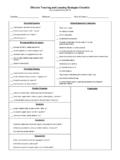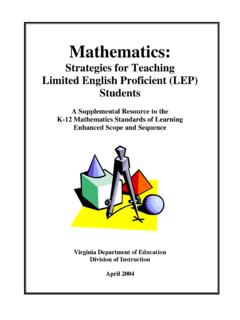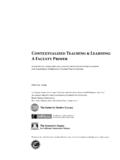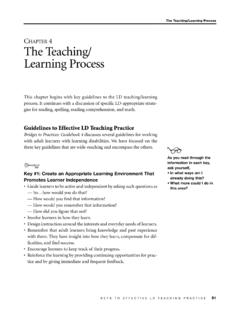Transcription of Myths about Teaching and Learning Second …
1 TESLR eporter37,2(2004), pp. 1-13 Myths about Teaching andLearningSecondLanguageVocabulary:What RecentResearch SaysKeith S. FolseUniversityofCentralFlorida,USAI ntroduction1 Learninga languageentailslearningnumerousaspectsab outthatlanguage,includingitspronunciatio n,writingsystem,syntax,pragmatics,rhetor icalmodesforreadingandcomposition,cultur e,andspelling, (L2)researchreflectsthisimportance,assee nin ( ,naturalcontextordirectinstruction)(Lauf er&Shmueli,1997;Zimmerman,1997),learners 'vocabularylearningstrategies(Gu,1994;Le ssard-Clouston,1994;Sanaoui,1995;Nassaji ,2003),thedevelopmentofL2learners'vocabu laries(Laufer,1998;Schmitt,1998.)
2 Nesselhauf,2003),the useofLlor L2 forinitialwordpresentation(Prince,1995;G race,1998),theeffectofdifferentpracticea ctivitiesonlearning(Joe,1995,1998;Folse, 1999),thenumberofwordsL2learnersneedtokn ow(Hazenberg&Hulstijn,1996),andwhichword sstudentsneedtoknow(Coxhead,2000;Liu,200 3).Thefindingsofthesestudiescastdoubtonc ommonmythsaboutL2vocabularyteachingandle arning(Folse,2004b).Thispaperfocuseson thefollowingeightmyths:(1)Vocabularyis not asimportantinlearninga foreignlanguageasgrammarorotherareas.(2) Itis notgoodto uselistsofwordswhenlearningvocabulary.(3 )Vocabularyshouldbepresentedinsemanticse ts.
3 (4) Theuseoftranslationsis apoorway tolearnnewvocabulary.(5)Guessingwordsfro mcontextis asproductiveforforeignlanguagelearnersas it is forfirstlanguagelearners.(6) Thebestvocabularylearnersmakeuseofonlyon e or twoeffectivespecificvocabularylearningst rategies.(7)Foreignlanguagelearnersshoul duse amonolingualdictionary.(8) thisarticle,I 1 Vocabulary is Not asImportantinLearninga ForeignLanguageasGrammaror Other AreasComprehensible input helps learners figure out how a language that a learner is hearing or reading has many unknown words , then that languageis not comprehensible and therefore cannot be words , without vocabulary,comprehensible input is neither comprehensible nor input.
4 Adult ESL learners are keenlyaware of their "vocabulary plight." Learnersneedvocabulary and see acquisition ofvocabulary as their greatest challenge (Green&Meara, 1995; Meara, 1980).Two of the mostimportantskills foracademic-boundESL students are readingand writing. TherelationshipbetweenL2vocabularyknowle dgeand L2 readingability is clear (Haynes, 1993; James, 1996). Huckin&Bloch (1993) point out,"Researchhas shown thatsecond-languagereaders rely heavily onvocabularyknowledge,and that a lack ofvocabularyknowledgeis the largest obstacle for Second -language readers toovercome"(p.)
5 154). Haynes and Baker (1993) found the mainobstacle for L2 readers not to be a lack of reading strategies but ratherinsufficientvocabularyknowledgein English. Laufer&Sim (1985) list these areas in order ofdecreasingimportancein reading ability in L2:knowledgeof vocabulary, subjectmatter, discourse markers, and syntactic , Laufer and Sim find thatvocabularyis most important, syntax least its role in L2 reading, a large L2 vocabulary base can have a significanteffect onlearners'writing skills (Laufer, 1998) and in listening and speaking tasks (Joe,1995).
6 Though correlation does not imply causality, empirical studies have shown thatgood L2 readers, writers, speakers, and listeners know much more far too long, the emphasis in ESL hasmistakenlybeen on grammar. Learnerscan expressthemselveswith poor grammar; in fact, much to the chagrin of ESLteachers,they do this ,withpoorvocabulary,communicationisconst rainedconsiderably. You can get by without grammar; youcannot get by without a foreign language learner in Latin America, Saudi Arabia, Malaysia, andJapan, I managed quite well with limited grammar; however, my worst and (inhindsight) sometimes funniestcommunicationbreakdownexperience swere when Idid not know theappropriatevocabulary.
7 On one occasion, I spent a long and tryinghour in a small store in Japan trying topurchaseflour without knowing the word forflourin Japanese. Icouldn'tdraw it. Icouldn'texplain it. At one point, I even triedsaying"pre-bread,"but thatjustproducedmore looks of end, I leftFolse-SecondLanguage Vocabulary Myths3the storewithoutthe flour. I hadmasteredbeginninglevel polite forms for"Excuseme, where is the__'l"but I did not know theJapaneseword forflourto fill in thatkey blank ofgrammarknowledgecan limitconversation;lack ofvocabularyknowledgecan UseListsofWordsWhenLearningVocabularyUsi ng lists may be boring for some learners, but there is noevidenceto show thatlearnersdo not fare well with lists, nor is thereempiricalevidencethatstudentswithou tlists farebetterthan those with lists.
8 In fact, some learners prefer be due to theireducationalbackgroundwhich relies heavily on rote Learning , or it could also be due toindividuallearner the reason, studentscanlearn from simple vocabulary lists can yield better vocabulary retention than relying on listswith more information, , example sentences. In a study of Hebrew speakers studyingEFL, Laufer and Shmueli (1997) compared four modes of presentation, including lists: (I) words presented in isolation, (2) words in minimal context, , in one meaningful sentence,(3) words in text context, and (4) words in elaborated text context.
9 Results showed that lessinformation was better. Retention scores for word recognition were superior when lessinformation or limited context was given about the word (as in modes 1 and 2) and inferiorwhen more information or extended context was given (as in modes 3 and 4).Inanotherstudy on the use of lists in Learning L2 vocabulary, Prince (1995)examinedthe role oflearners'L2proficiencyand mode ofpresentation, ,Lltranslationsor L2context(in a series of L2 sentences).Prince found that lessproficientstudents were able to recall more items when they hadlearnedthe words inthetranslationconditionrather than in ,thisresearchshowed that some studentsperformbetterwhen they were given only a list of L2words and because a list can be effective does not mean that teachers should hand a list tostudents and ask them to learn the list.
10 The content of the list is the target, and it is up tothe teacher to come up with ways to present sections of the list to students in interesting,meaningful ways and then provide relevant oral and written practice good lists exist fordifferenttypes of learners. Very young learners mightbenefitfrom the Dolch list, which is a list of 220 sight words , socalledbecausethesehigh frequency words do not follow the basic rules ofEnglishphonics and mustthereforeberecognizedby sight, not bysoundingthem out. The list waspreparedin4 TESLR eporter1936 but is still relevant; it includes mostly function words and isespeciallyuseful forkindergarten to middleelementarylevel promising lists for adult learners are the University Word List (UWL) and theAcademic Word List (AWL).







